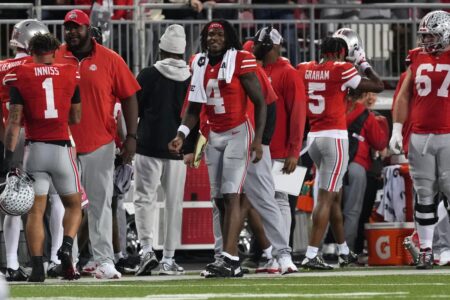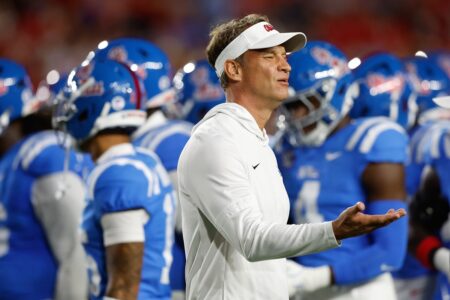The USS Gerald R. Ford, the United States’ most advanced aircraft carrier, arrived in the Caribbean Sea on Sunday, the U.S. Navy confirmed, amid rising tensions between the U.S. and nearby nations. Days earlier, Venezuelan President Nicolas Maduro, whom Washington does not recognize as the country’s legitimate leader, called for peace between the two nations.
Newsweek has reached out to the Pentagon and Navy for comment via email on Sunday.
Why It Matters
The Trump administration is continuing to build up its military campaign in the Caribbean where it has deployed naval and air forces in what it has framed as a crackdown on narcotics smuggling.
At least 80 people have been killed in U.S. strikes on 20 alleged drug boats in the southern Caribbean and eastern Pacific since early September. Trump and other top officials have said these vessels were carrying drugs bound for the U.S.
Operation Southern Spear has quickly become one of Washington’s most far-reaching regional security initiatives in years, placing significant pressure on Maduro as tensions between Caracas and Washington intensify. The operation’s mission is to enhance security and stability by “detecting, disrupting, and degrading transnational criminal and illicit maritime networks.”
The U.S. does not recognize Maduro as the legitimate president of Venezuela, accusing him of stealing last year’s election.
What to Know
The military’s confirmation of Ford’s arrival on Sunday brings the total amount of U.S. troops in the region to around 12,000, according to the Associated Press. The carrier has more than 4,000 sailors and dozens of tactical aircraft onboard, the Navy said in a Sunday press release. The carrier was relocated from the Mediterranean with several reports of it moving south from Puerto Rico into the Caribbean earlier this week.
The carrier’s strike group includes “nine embarked squadrons of Carrier Air Wing Eight, Destroyer Squadron Two’s Arleigh Burke-class guided-missile destroyers USS Bainbridge (DDG 96) and USS Mahan (DDG 72), and the integrated air and missile defense command ship USS Winston S. Churchill (DDG 81).”
The U.S.’s mounting military display in the sea builds upon a several monthslong pressure tactic. Deployment and positioning of aircraft carriers is a long used military tactic to pressure and deter warfare, as carrier strike groups stationed at sea can often hit targets inside countries.
American troops are coordinating “training exercises” with Trinidad and Tobago’s forces, the Minister of Foreign Affairs Sean Sobers said. The country is only about 7 miles off of the coast of Venezuela, and government officials say the exercises will continue throughout the week, according to the AP.
Earlier this week, Venezuela mobilized nearly 200,000 troops in a large-scale effort to prepare for potential U.S. strikes. On Thursday, Maduro called upon Trump “to unite for the peace of the continent,” telling a CNN reporter, “no more endless wars. No more unjust wars.”
He reiterated his message to Trump as “peace. Yes, peace.”
Maduro has accused the Trump administration of seeking to remove him, while the U.S.-backed opposition has renewed calls for an imminent regime change. U.S. authorities have offered a $50 million reward for information leading to Maduro’s arrest. He faces narcoterrorism and other drug-related charges in the U.S.
What People Are Saying
Admiral Alvin Holsey, Commander, SOUTHCOM, said in a Sunday press release: “Through unwavering commitment and the precise use of our forces, we stand ready to combat the transnational threats that seek to destabilize our region. The USS Gerald R. Ford Carrier Strike Group’s deployment represents a critical step in reinforcing our resolve to protect the security of the Western Hemisphere and the safety of the American Homeland.”
Rear Admiral Paul Lanzilotta, commander of Carrier Strike Group 12, said in a Sunday press release: “Our nation’s leaders have called upon the Gerald R. Ford Carrier Strike Group as the most capable, adaptable, and lethal platform in the world to be where it matters, when it matters. Our force will augment existing capabilities to protect our nation’s security and prosperity against narco-terrorism in the Western Hemisphere.”
Elizabeth Dickinson, the International Crisis Group’s senior analyst for the Andes region told the AP on Sunday: “This is the anchor of what it means to have U.S. military power once again in Latin America. And it has raised a lot of anxieties in Venezuela but also throughout the region. I think everyone is watching this with sort of bated breath to see just how willing the U.S. is to really use military force.”
Mark Cancian, senior defense adviser at the Center for Strategic and International Studies, previously told Newsweek amid reports of Ford’s deployment: “There’s no strategic rationale for sending the Ford to the region unless it’s intended for use against Venezuela. The shot clock is now running—this carrier can’t just sit idle. They’ll either need to act or redeploy it, and pulling back would amount to backing off.”
What Happens Next?
It’s unclear what the U.S. military’s move next move in the Caribbean is. Last month, Trump had authorized the CIA to carry out covert operation in Venezuela.
Read the full article here














